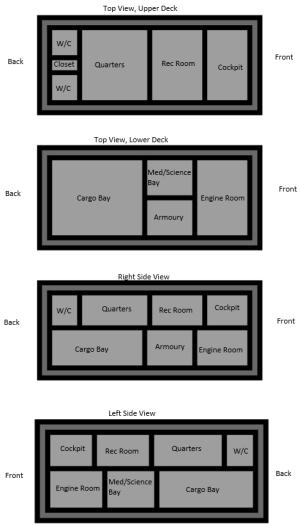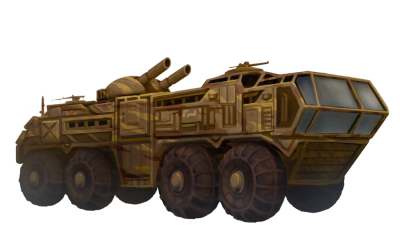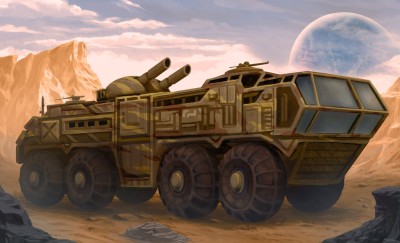Table of Contents
URSA Armoured Transport Unit
The URSA ATU was designed by Galactic Horizon in YE 40 as a heavy operations unit for expedition journeys and in more extreme cases, an armed and mobile small fortress.
About the URSA A.T.U
The URSA is a large land based vehicle, with wheels designed to traverse rough terrain and equipped with few weapons on the base model for self-defense. It's available on the open market like all Horizon products and can be custom designed to order with slight modifications available to interior sizing and the option to install optional extras if provided by the buyer or from the Horizon range. The mammoth like vehicle is built by Galactic Horizon all custom orders are handled personally by Anaska DePolanskaya to ensure the best possible quality.
| Stats | |
|---|---|
| Fielded by: | Horizon Expeditionary Force, open market |
| Type: | Armoured Transport Unit |
| Class: | K9 Carrier Class |
| Nomenclature: | GH-K9-3O |
| Designer: | Galactic Horizon |
| Manufacturer: | Galactic Horizon |
| Production: | YE 40 |
| Price: | 100,000 KS |
| Crew: | 51) |
| Maximum Capacity: | 30 |
| Passenger Capacity: | 30 |
| Width: | 18 meters (59 feet) |
| Length: | 36 meters (118 feet) |
| Height: | 18 meters (59 feet) |
Key Features
The URSA has several unique features to set it apart as one of the top class Horizon products. As the biggest ground vehicle at the time of development in the Horizon garage, it contains many onboard features of a spcecraft or building with plenty of room for the specific rooms and facilities. These rooms and room spaces are completely modular and can have their contents switched out for almost anything else to allow for more customisation control for the buyer.
The wheels are composed of a special mesh design that removes the need for air filled tires and drastically increases their resistance to hazardous terrain, requiring severe damage to hinder their function. Due to the mesh composition each wheel has some built in suspension and distribution properties of its own before needing to rely on the suspension of the vehicle itself, this all assists the URSA in traversing the toughest terrain including inclines up to 40 degrees.
Each gun platform, one at each end of the vehicle, contains one Orbit Jumper and one Shooting Star and are both manned stations with the Dawn AI built in to assist with targeting and tracking however they cannot operate independently on this AI. Atop the vehicle there are designated areas suited for armed members of the crew to have an armoured firing position to use handheld weapons to repel boarders and attackers, there is 2 stations facing front and back and 4 along each side.
In addition to its offensive ability the URSA can support a full crew of 30 for up to 2 days submerged in water or suitable terrain such as mud and sand, this ability is achieved through the use of sealing all openings and relying on stored oxygen reserves. It cannot operate while submerged as it is a purely defensive feature designed to allow the crew to evade detection when needed.
History
Designed and field tested in mid YE 40 by Galactic Horizon the URSA A.T.U. was the biggest vehicle designed by the small corp when completed, rivaling the size of some mechs. The idea behind the concept was brought on by a quiet chat between Uso and Riccard Black, while not best friends or even that close on business terms they had goals that overlapped in desired outcomes which led to the creation of the Horizon Expeditionary Force providing the need for a large heavy vehicle, and thus the URSA was born.
With a sizeable amount of applications to join the expedition being received by the company, the URSA concept was designed and theorised, accounting for a large crew and needing to defend itself while also being reasonably mobile the design was a challenge. While original concepts posed a much larger vehicle to mount more guns on and include more features the issue of speed always blocked the concept from progressing. After a complete redesign by several of the most experienced macro engineers including Anaska, the size was reduced as well as the number of guns and needless extras.
The next stage of development consisted of finding the best materials and designs for each component and piece of the large vehicle which had been nicknamed, “The Rolling Fortress” because of said size and defensive capability. With rough and hazardous terrain being a primary concern the propulsion and movement systems became a prime development section, eventually the team settled on a special design to remove the risk of tire blowouts or damage entirely while providing excellent movement capacity.
Rivals
The URSA has no specific rivals but does have a class of rival vehicle, while the URSA is armoured from the outside and armed to deal with both land and air vehicles its weakening factor is speed and mobility, any attacker on the ground with enough speed and agility coupled with hefty firepower would be in a position to slowly strip the armour of an URSA. Alternatively should a combat class starship with excessive firepower attack an URSA it would be annihilated, this is very unlikely to happen given the operational area suited to an URSA.
Appearance
The URSA's general appearance resembles a large, wide truck with 4 wheels on either side that keep the chaises far enough off the ground to accommodate the harsh terrain it's designed to move over. At the front of the vehicle is a slightly protruding cockpit with a large curved front window made of tinted ARTCS2) that is thick enough to protect the operators from both gunfire3) and light radiation. On each side of the body is a personnel access point with slide out ramp for stationary use and retractable ladder in the body above and below the access point for use while the vehicle is in motion.
The back of the URSA is almost entirely taken up by a large cargo ramp door with several small slits for crew to gun through, these can be sealed if needed such as during submersion or to avoid hostile fire. Atop the large trapezoid body are two main weapon platforms each with a missile launcher and machine cannon as well as a small protected targeting visual sensor.
The URSA comes standard in mottled beige colouring with the option to have it recoloured based on designs submitted by the buyer.
Speed and Distance
Ground speed: 100km/h maximum speed on favorable terrain Range: several months if fully stocked Lifespan: expected operation life of upwards of 20 years if maintained every 3 years
Damage Capacity
See Damage Rating (Version 3) for an explanation of the damage system.
- SARPv3 Tier: 9 Heavy Mecha
- The URSA Transport's Durandium Alloy armor has the defensive profile of a Tier 9 Heavy Mecha.
- The URSA Transport's has a bubble barrier rated for Tier 4 Light Armor that cover the turrets only.
Interior
List of interior information that is of particular importance or should be noted for use in RP 
Cockpit: - At the front of the cockpit facing straight ahead is the driver station on the right and navigator station on the left however if needed the navigator can act as a secondary driver. On each side towards the rear of the cockpit are the weapon operator stations, one for each weapon platform and in the center behind the driver and navigator is the engineer station. While not required to be in their station at all times the cockpit provides instant access to the reactor room below for fast access if only a single engineer is on board.
Entrance/Exits: - There are two sliding doors, one on each side of the body near the front of the cargo bay as well as the main cargo ramp door at the rear of the vehicle. For access to the roof of the vehicle for repairs or combat there is two access hatches one at the front and one at the back, all outside entrance/exits can be sealed to create a controlled environment within the vehicle for submersion purposes.
Rooms: - Each room is connected to its neighbor via a simple automatic sliding door which can be manually operated and locked in emergency cases, they are even able to be fully sealed if the need arises. In the rear-center of the interior is a sloped access ladder for moving between the levels. Each room has fittings in the floor and walls for removable furniture or equipment as well as some standard equipment which is detailed later.
Weapons Systems
The URSA A.T.U features two manually controlled weapons platforms, one at the Stern of the vehicle and one on the Bow, both are equipped with a Orbit Jumper Missile System and a Shooting Star Machine Gun.
- Stern weapons platform
- 1x Orbit Jumper Missile System Tier 7 - Light Anti-Mecha
- Includes Autoloader
- Includes a MOASS as the targeting camera
- 1x Shooting Star Machine Gun Tier 6 - Heavy Anti-Armour
- Includes a MOASS as the targeting camera
- 1x Bubble Blower Grenade as defensive shield
- Bow weapons platform
- 1x Orbit Jumper Missile System Tier 7 - Light Anti-Mecha
- Includes Autoloader
- Includes a MOASS as the targeting camera
- 1x Shooting Star Machine Gun Tier 6 - Heavy Anti-Armour
- Includes a MOASS as the targeting camera
- 1x Bubble Blower Grenade as defensive shield
Onboard Systems Descriptions
List of onboard systems within the URSA that may be of particular importance for RP
Power Generator: The URSA is powered by one prototype smaller scale Phoenix Fusion Generator which provides ample power to run the vehicle movement as well as all onboard electronics and weapons platforms.
Processor: The URSA has a limited access version of the Dawn AI which monitors and reports on the status of onboard systems as well as assisting in targeting and navigation.
Atmospheric grade life support: Using a simple sealed door and onboard oxygen reserve system, the URSA can sustain a full crew for up to two days within the sealed body in pressure up to 2.5g, after which the body will begin to collapse and seals will break.
Satellite link: Using data from a satellite link the URSA can use its Dawn AI to map various routes to selected destinations as well as provide information about what conditions will be expected during the journey, this can also be achieved if given user input data. The satellite link also serves as a communication method for long distance and to a lesser extent, off world communication.
Cargo Capacity
The URSA has a large cargo bay4) with modular fittings allowing it to be outfitted to store everything from small vehicles to crates of gum in excess, with this space occupied entirely by supplies the URSA could support a full crew of 30 for up to 4 months before needing to restock. If holding vehicles, up to 6 Redbacks can be stored while leaving room for enough supplies to last a full crew for a month and a half.
Standard Equipment
The URSA A.T.U contains the following equipment in the standard model:
- A cockpit at the Stern of the vehicle5)
- A driver's seat
- navigator's/communications station
- 2x gunner stations hooked up to the turrets
- floor hatch that leads to the reactor chamber, can be easily hidden
- Rec room on the top deck, a mostly empty room that the buyer may outfit as they wish.6)
- A kitchen module built into an alcove in the port-side wall of the rec room
- Kitchen module contains an induction oven, a freezer chest, two microwaves, a sink, dishwasher, cupboards and a fridge.
- A laundry module built into an alcove in the starboard-side wall of the rec room
- Laundry module contains two washing machines, two dryers, one steam cleaner and two ironing boards
- Crew Quarters in the Bow of the top deck7)
- Thirty basic, double stacked bunks for personnel, each bunk has a footlocker built in to the foot of the bed8)
- Two water closets in the very rear of the Quarters. 9)
- Each water closet contains a combined shower/bath, a self cleaning toilet and a hand basin with a mirror and draws.
- A supply closet filled with clearing supplies10).
- Two fold up impact cushioning benches on both sides of the cargo bay which can seat 8 a piece.
- A modular armoury in the vehicle's belly, situation between the reactor chamber and the cargo bay11)
- A combined modular science/medical bay next to the armoury to be outfitted as the buyer sees fit.12)
- Sterile, pressure controlled environment that has a quarantine cell made of Anti-Reflective Transparent Constructs (ARTCs) 13).
- A reactor chamber at the front of the bottom deck, houses the Phoenix Fusion Generator.14)

